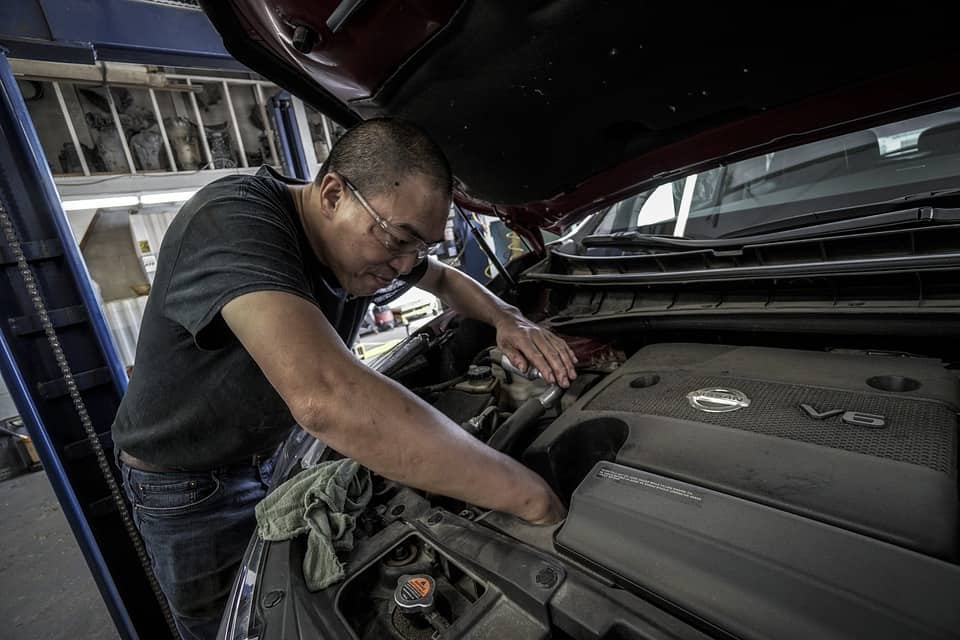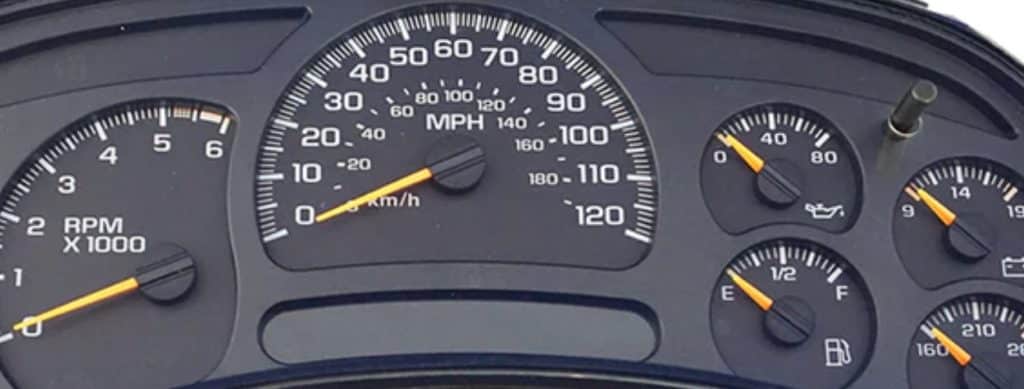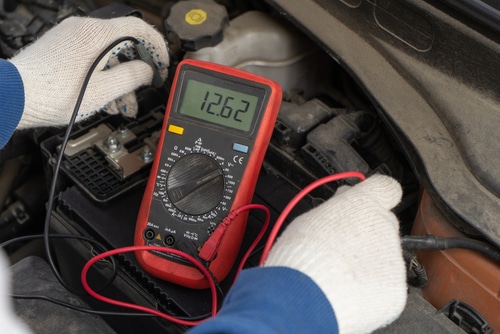Editor’s Note: A check engine light that comes on and off indicates should be looked in to. A FLASHING check engine light is a SERIOUS problem.

Ah, the dreaded check engine light – that mysterious glowing beacon on your dashboard that can strike fear into the hearts of even the most seasoned drivers. But what if it’s playing a game of peek-a-boo, flashing on and off like a temperamental firefly?
Don’t worry, you’re not alone in this automotive game of hide-and-seek.
The intermittent flashing of your check engine light often indicates a minor issue, such as a loose gas cap or a temporary glitch in the engine’s sensors.
While it might be tempting to ignore this blinking pest, it’s best to pay attention to what your car is trying to tell you. After all, it’s not every day that your vehicle attempts to communicate with you through Morse code.

So, buckle up and get ready to dive into the world of flickering dashboard lights.
We’ll explore why your check engine light might be playing this annoying game of on-again-off-again, and what you can do to put an end to its shenanigans.
Trust me, by the end of this article, you’ll be the Sherlock Holmes of automotive diagnostics – or at least feel a little less panicked when that pesky light decides to make an appearance.
Key Takeaways
- An intermittently flashing check engine light usually indicates a minor issue
- Addressing the problem promptly can prevent more serious and costly repairs
- Regular maintenance and prompt attention to warning lights can keep your vehicle running smoothly
Understanding the Check Engine Light
The check engine light is your car’s way of telling you something’s amiss. It’s like that friend who always points out when you’ve got spinach in your teeth – annoying, but ultimately helpful.
The Role of the Onboard Diagnostics (OBD) System
Your car’s OBD system is like a team of tiny mechanics living inside your engine. They’re constantly checking things and taking notes. When something’s not right, they light up that pesky check engine light on your dashboard.
The OBD2 system, the newer and cooler version, has been standard in cars since 1996.
It’s so hip, it even speaks in code! These codes are what mechanics use to figure out what’s wrong with your car.
Got a check engine light that won’t quit? You might want to invest in an OBD2 scanner. It’s like a translator for your car’s secret language.
Interpreting Check Engine Light Codes
When your check engine light comes on, it’s storing a DTC (Diagnostic Trouble Code). These codes are like cryptic messages from your car. Each one starts with a letter followed by four numbers.
For example, P0300 means your engine’s misfiring. It’s like your car’s way of saying, “Hey, I’ve got hiccups!”
To read these codes, you’ll need that OBD2 scanner we talked about earlier. Just plug it in, and voila! You’re speaking car.
Remember, though, the code is just the starting point. It’s like a doctor getting your temperature – it tells you something’s wrong, but not necessarily what or why.
Common Causes for Check Engine Light Activation

Your check engine light can be triggered by various issues, from simple fixes to more complex problems. Let’s explore some of the most frequent culprits that might be causing that pesky light to illuminate your dashboard.
Loose or Faulty Gas Cap
You’d be surprised how often a simple gas cap can throw your car into a tizzy. A loose or faulty fuel cap can cause your check engine light to come on faster than you can say “fill ‘er up!”
When your gas cap isn’t properly sealed, it allows fuel vapors to escape. This triggers your car’s evaporative emissions system, and voila – that dreaded light appears.
Next time you’re at the pump, give your gas cap a good twist. You might hear a clicking sound when it’s fully tightened.
If your cap is cracked or damaged, it’s time for a replacement. It’s a cheap fix that might save you from unnecessary worry.
Oxygen Sensor Issues
Your car’s oxygen sensor is like a tiny detective, always sniffing out the air-fuel mixture in your engine. When it goes bad, your check engine light might start playing peek-a-boo.
A faulty O2 sensor can’t properly measure the amount of unburned oxygen in your exhaust system. This can lead to poor fuel economy and increased emissions. You might notice your car running rough or stalling.
Replacing an oxygen sensor isn’t a DIY job for most folks. It’s best to let a professional handle this one. They can diagnose the issue and replace the sensor if needed.
Problems with Catalytic Converter
Your catalytic converter is the unsung hero of your car’s emission system. It works tirelessly to convert harmful exhaust gases into less harmful emissions.
When your catalytic converter starts to fail, it can trigger your check engine light. You might notice a decrease in performance, reduced fuel efficiency, or even a rotten egg smell from your exhaust.
Catalytic converter issues often stem from other problems, like misfires or oil leaks. It’s crucial to address these underlying issues to prevent further damage.
Mass Airflow Sensor Malfunction
The mass airflow sensor is like your engine’s personal dietician, measuring the amount of air entering the engine to determine how much fuel is needed.
When this sensor goes haywire, your engine might start running too rich or too lean. You could experience stalling, jerking, or hesitation during acceleration. Your fuel economy might take a nosedive too.
Cleaning your mass airflow sensor might solve the problem. But if it’s truly malfunctioning, replacement is usually the best option. Don’t worry, it’s not as expensive as some other engine repairs.
Spark Plugs and Ignition Coil Errors
Spark plugs and ignition coils are the dynamic duo of your engine’s ignition system. When they’re not playing nice, your check engine light might decide to join the party.
Worn spark plugs can cause misfires, rough idling, and poor acceleration. Faulty ignition coils can lead to similar symptoms. Both can trigger your check engine light.
Regular maintenance can help prevent these issues. Replace your spark plugs according to your vehicle’s maintenance schedule. If you’re experiencing ignition-related problems, have a mechanic check your ignition coils too.
Symptoms and Types of Check Engine Lights
Your dashboard’s check engine light can be a real party pooper, but understanding its behavior and associated symptoms can save you from a roadside meltdown. Let’s dive into the fascinating world of these illuminated annoyances.
Solid vs. Flashing Lights
Ever noticed your check engine light doing its best impression of a disco ball? That’s not a good sign, folks.
A solid check engine light is like your car clearing its throat – it needs attention, but it’s not screaming for help. It could be something simple, like a loose gas cap or a minor sensor hiccup.
Now, if that light starts flashing like it’s at a rave, buckle up buttercup – you’ve got trouble.
A flashing check engine light is your car’s way of saying, “Houston, we have a problem!” This usually means there’s a serious issue that could damage your catalytic converter. Time to pull over and call for backup!
Performance Related Symptoms
When your check engine light decides to join the party, it often brings some unwelcome friends. You might notice your car acting like it’s had one too many:
- Rough idling or stalling (it’s not taking a nap, promise)
- Loss of power (suddenly, that hill feels like Everest)
- Reduced fuel efficiency (your wallet will feel this one)
- Unusual noises (if it sounds like a symphony of rattles, that’s bad)
These symptoms are your car’s way of saying, “Hey, remember that light I turned on? Yeah, I meant it.”
Don’t ignore these signs – your car isn’t being dramatic, it genuinely needs your attention. The sooner you address these issues, the less likely you’ll end up stranded on the roadside, telling your car, “I thought we were friends!”
When to Visit the Mechanic
Knowing when to take your car to the shop can save you time, money, and headaches. Let’s look at when you should high-tail it to your friendly neighborhood grease monkey and when you can take a more leisurely approach.
Immediate Attention for Flashing Lights
If your check engine light starts doing the cha-cha on your dashboard, it’s time to pull over and call for backup.
A flashing light means your car is having a tantrum, and it needs a professional to calm it down pronto.
Don’t try to be a hero and drive your car in this condition. You might end up cooking your catalytic converter, and trust me, that’s a recipe for disaster (and an empty wallet).
Get your ride towed to a repair shop. The mechanics there will plug in their fancy diagnostic tools and decode those trouble codes faster than you can say “transmission fluid.”
Routine Checks for Solid Lights
When your check engine light is solid, it’s like your car is clearing its throat – it wants attention, but it’s not screaming for it. You’ve got some wiggle room here, but don’t procrastinate too long.
First, check the easy stuff. Is your gas cap loose? Tighten it and see if the light goes out after a few trips.
If not, it’s time to book an appointment with your mechanic.
Don’t ignore that glowing amber beacon. It could be something simple like a wonky oxygen sensor or spark plugs past their prime. But it might also be your car’s way of saying, “Hey, I need some love from a professional!”
Preventing Future Check Engine Light Issues

Keeping that pesky check engine light at bay doesn’t have to be rocket science. With a little know-how and some elbow grease, you can save yourself from future headaches and costly repairs.
Regular Maintenance Tips
You know that oil change sticker on your windshield? It’s not just for decoration.
Regular oil changes are your engine’s best friend. They keep those moving parts happy and reduce wear and tear.
Don’t forget about your air filter either. A clean filter helps your engine breathe easy and can improve fuel efficiency.
It’s like giving your car a nice, deep breath of fresh air.
Spark plugs might be small, but they pack a punch.
Replace them according to your owner’s manual to keep your engine firing on all cylinders. Trust me, your car will thank you.
Keep an eye on your coolant levels too.
Low coolant can lead to engine overheating faster than you can say “tow truck.”
A quick check now and then can save you from a steamy situation down the road.
Using Diagnostic Tools at Home
Ever wished you could speak “car”? Well, now you can with a handy FIXD sensor.
These nifty gadgets plug into your car’s computer and translate those mysterious engine codes into plain English.
With a diagnostic tool, you can play detective and catch small issues before they become big problems.
It’s like having a tiny mechanic living in your glove box.
Some tools even give you real-time data on your engine’s performance.
You’ll feel like a NASCAR pit crew chief, minus the firesuit and headset.
Remember, these tools are great for spotting issues, but don’t go wild with DIY repairs if you’re not sure what you’re doing.
Sometimes, it’s best to leave it to the pros.
Frequently Asked Questions
Check engine lights that come on and off can be puzzling. Let’s tackle some common head-scratchers about this pesky dashboard warning.
Why would my check engine light turn on briefly and then shut off as if nothing happened?
Your car might be playing a little game of “gotcha!”
This can happen due to a loose fuel cap or a temporary glitch in the system.
It’s like your car had a brief moment of panic, then realized everything’s fine.
Is it possible for the check engine light to blink on during acceleration and then go off, and what could cause this?
Yep, it’s possible!
This could be your car’s way of saying, “Whoa, slow down, hot rod!”
It might be struggling with fuel mixture or ignition during acceleration.
Think of it as your car getting a bit winded on a sprint.
Could my vehicle be running just fine even though the check engine light comes on occasionally? How?
Absolutely!
Your car might be running smoother than a buttered-up bowling ball, even with that pesky light.
Minor issues like a slightly loose gas cap or a small emissions hiccup can trigger the light without affecting performance.
Should I be concerned if my check engine light illuminated for a day and then mysteriously turned off?
It’s like your car had a 24-hour bug.
While it’s not an immediate cause for panic, it’s worth keeping an eye on.
The issue might have resolved itself, but if it happens again, you might want to get it checked out.
What does it mean if my car’s check engine light comes on intermittently but there are no error codes detected?
This is like your car playing a game of hide-and-seek with you.
Intermittent issues can be tricky to pin down. It could be a sensor acting up or a loose connection that’s not consistent enough to store a code.
How long should I wait to see if my check engine light turns off on its own before seeking a mechanic’s help?
Don’t play the waiting game too long.
If the light doesn’t go off after a few days or a couple of drive cycles, it’s time to call in the pros.
Your car might need a little TLC from someone who speaks its language.
